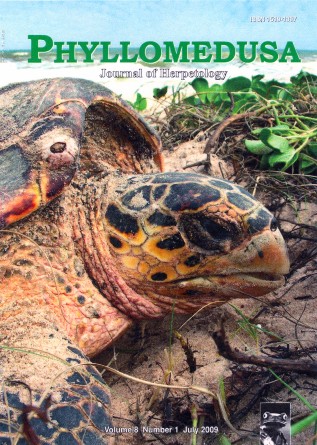Nest site selection and hatching success of hawksbill and loggerhead sea turtles (Testudines, Cheloniidae) at Arembepe Beach, northeastern Brazil
DOI:
https://doi.org/10.11606/issn.2316-9079.v8i1p03-17Keywords:
Testudines, Cheloniidae, Caretta caretta, Eretmochelys imbricata, nesting preference, conservation, BrazilAbstract
Nest site selection influences the hatching success of sea turtles and represents a crucial aspect of their reproductive process. Arembepe Beach, in the State of Bahia, northeastern Brazil, is a known nest site for Caretta caretta and Eretmochelys imbricata. For the nesting seasons in 2004/2005 and 2005/2006, we analyzed the influence of beach profile and amount of beach vegetation cover on nest site selection and the hatching success for both species. Loggerhead turtles nested preferentially in the sand zone, while hawksbill turtles demonstrated no preferences for either sand or vegetation zone. Beach vegetation was important in the modulation of nest site selection behavior for both species, but the amount of beach vegetation cover influenced (negatively) hatching success only for the hawksbill, mainly via the increment of non-hatched eggs. Hatching success, outside the tide risk zone, was not influenced by the position of the nests along the beach profile. The pattern of nest distribution by species indicated that management of nests at risk of inundation and erosion by the tide is more important for loggerhead turtles than for hawksbill turtles. Beach vegetation is an important factor in the conservation of these sea turtle species. Nests that are at risk due to tidal inundation and erosion can be translocated to any position along the beach profile without producing any significant effect on hatching success, as long as high densities of beach vegetation cover are avoided for hawksbill nests. It is important to point out that the pattern we report here for distribution of hawksbill nests along the beach profile could be due in part to the influence of pure and hybrid individuals, since there are reports of hybridization among hawksbills and loggerheads to the study site.Downloads
Download data is not yet available.
Downloads
Published
2009-06-01
Issue
Section
Articles
License
All material originally published in Phyllomedusa belongs to Escola Superior de Agricultura Luiz de Queiroz - Universidade de São Paulo. All contents are under a license of Creative Commons BY-NC-ND.How to Cite
Serafini, T. Z., Lopez, G. G., & Rocha, P. L. B. da. (2009). Nest site selection and hatching success of hawksbill and loggerhead sea turtles (Testudines, Cheloniidae) at Arembepe Beach, northeastern Brazil. Phyllomedusa: Journal of Herpetology, 8(1), 03-17. https://doi.org/10.11606/issn.2316-9079.v8i1p03-17



 Impact Factor (JCR): 0.400
Impact Factor (JCR): 0.400 CiteScore: 1.0
CiteScore: 1.0